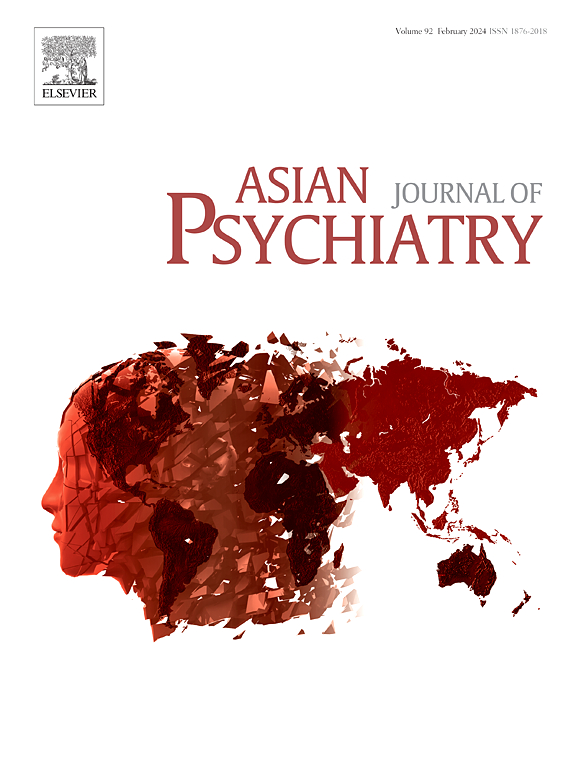探讨首发精神分裂症患者精神症状与认知功能之间的关系:网络分析
IF 3.8
4区 医学
Q1 PSYCHIATRY
引用次数: 0
摘要
背景首发精神分裂症是干预治疗精神分裂症的关键时期。了解精神症状和认知功能之间的复杂关系对于早期精确干预和预测疾病结果至关重要。以往的研究在很大程度上忽略了这一问题,传统的基于预先建立的理论假设的分析方法是不够的。本研究旨在利用基于图论的网络分析来解决这一差距。方法采用Positive and Negative Syndrome Scale (PANSS)对患者进行精神症状评估。认知功能评估采用韦氏成人智力量表(WAIS)的数字符号和信息子测试,分别衡量信息处理效率和一般知识。在这些评估的基础上构建了一个精神症状和认知功能的网络。结果网络分析结果显示,阴性症状节点为中心。值得注意的是,N1节点(钝化影响)与数字符号节点呈负相关,这是唯一与认知功能相关的精神症状节点。社区检测分析表明,认知、阳性症状和阴性症状节点倾向于在各自的类别内聚集,而一般精神病理节点则倾向于与不同类型的节点聚集。一些一般精神病理淋巴结被分离出来,反映了首发精神分裂症患者某些精神症状的隐蔽性。结论本研究创新性地应用网络分析法探讨中国首发精神分裂症患者精神症状-认知功能网络的特点。这些发现为有针对性的基于症状的干预和预测首发精神分裂症的疾病结局提供了有价值的理论见解。本文章由计算机程序翻译,如有差异,请以英文原文为准。
Exploring the associations between psychiatric symptoms and cognitive functions in first-episode schizophrenia: A network analysis
Background
First-episode schizophrenia represents a critical period for intervention in the treatment of schizophrenia. Understanding the intricate relationships between psychiatric symptoms and cognitive functions is vital for early precise intervention and predicting illness outcomes. Previous research has largely overlooked this issue, and traditional analytical methods based on pre-established theoretical assumptions are insufficient. This study aims to address this gap by utilizing graph theory-based network analysis.
Methods
The study employed the Positive and Negative Syndrome Scale (PANSS) to assess psychiatric symptoms. Cognitive functions were evaluated using the Digit Symbol and Information subtests from the Wechsler Adult Intelligence Scale (WAIS), which measure information processing efficiency and general knowledge, respectively. A network of psychiatric symptoms and cognitive functions was constructed based on these assessments.
Results
The network analysis revealed that negative symptom nodes were central. Notably, node N1 (Blunted affect) showed a negative correlation with the Digit Symbol node, being the only psychiatric symptom node linked to cognitive functions. Community detection analysis indicated that cognitive, positive symptom, and negative symptom nodes tended to cluster within their respective categories, while general psychopathology nodes showed a tendency to cluster with various types of nodes. Some general psychopathology nodes were isolated, reflecting the concealed nature of certain psychiatric symptoms in first-episode schizophrenia patients.
Conclusion
This study innovatively applies network analysis to explore the characteristics of the psychiatric symptom-cognitive function network in Chinese patients with first-episode schizophrenia. The findings provide valuable theoretical insights for targeted symptom-based interventions and for predicting disease outcomes in first-episode schizophrenia.
求助全文
通过发布文献求助,成功后即可免费获取论文全文。
去求助
来源期刊

Asian journal of psychiatry
Medicine-Psychiatry and Mental Health
CiteScore
12.70
自引率
5.30%
发文量
297
审稿时长
35 days
期刊介绍:
The Asian Journal of Psychiatry serves as a comprehensive resource for psychiatrists, mental health clinicians, neurologists, physicians, mental health students, and policymakers. Its goal is to facilitate the exchange of research findings and clinical practices between Asia and the global community. The journal focuses on psychiatric research relevant to Asia, covering preclinical, clinical, service system, and policy development topics. It also highlights the socio-cultural diversity of the region in relation to mental health.
 求助内容:
求助内容: 应助结果提醒方式:
应助结果提醒方式:


